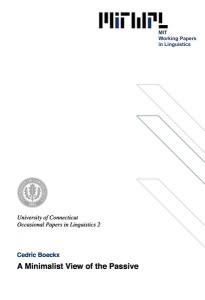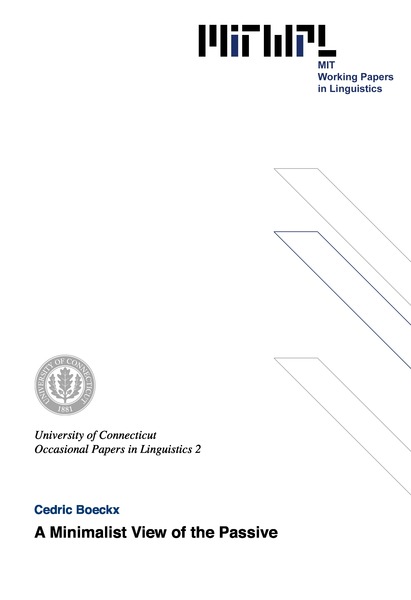A Minimalist View of the Passive
C. Boeckx, 1998
Table of Contents
A Minimalist View on the Passive
Acknowledgements
List of abbreviations
Abstract
0. Introduction (1)
0.1. Situating linguistic theory (1)
0.2. The second conceptual shift: epistemological remarks (7)
0.3. The Minimalist program (12)
0.4. Reconsidering the status of generative grammar: the new comparative approach (18)
0.5. Is there a passive? (19)
0.5.1. The standard view (21)
0.5.2. Trace theory (23)
0.5.3. GB-approaches to the passive (24)
0.5.3.1. Burzio's Generalization (25)
0.5.3.2. Jaeggli (1986) and Baker, Johnson & Roberts (1989) (28)
0.6. Organization and scope (32)
1. The Lexicon-As-Interface Hypothesis (36)
1.1. Where does morphology properly belong?: ongoing tug-of-war between syntax and lexicon (36)
1.1.1. "Remarks" and the lexicalist hypothesis (37)
1.1.2. UTAH and the 'new' morphology (38)
1.1.2.1. UTAH (39)
1.1.2.2. The Mirror Principle (44)
1.2. The Minimalist reaction (46)
1.2.1. Checking theory (47)
1.2.2. Checking or distributing morphology (50)
1.2.2.1. Distributed Morphology (50)
1.2.2.2. Why checking should be favoured (51)
1.2.3. Lexical-syntax (55)
1.2.4. Back to syntax (57)
1.2.4.1. Minor deviations from Minimalism (57)
1.2.4.2. Minimalist theories and Abstract Syntax (60)
a. Thematic decomposition (63)
b. Lexical decomposition (67)
1.3. A way out of the paradox: a new architecture for UG (76)
1.3.1. The lexicon-as-interface hypothesis (77)
1.3.2. Conceptual Structure (80)
1.3.2.1. The status of θ-theory (82)
a. Merging under Generalized Transformation (86)
b. θ-discharge (90)
1.3.2.2. The semantic readability of syntactic representations (94)
1.3.3. Organization of the lexicon (95)
1.3.3.1. Features (96)
1.3.3.2. +Interpretability (98)
1.4. Conclusions (107)
2. Coming closer to passives: participle agreement and auxiliary selection (110)
2.1. Past participle agreement (110)
2.1.1. The Kaynian view: AGRo (111)
2.1.2. Siloni & Friedemann (1993): AGRpart (113)
2.1.2.1. Hebrew (114)
2.1.2.2. French and Italian (117)
2.1.2.3. Scandinavian (122)
2.2. Auxiliary selection (126)
2.2.1. Be and have in Germanic and Romance (126)
2.2.1.1. Basic facts (129)
2.2.1.2. Previous accounts (130)
2.2.2. Have-less languages (133)
2.2.2.1. Georgian (133)
2.2.2.2. Irish (135)
2.2.3. Against equating passives and perfectives (140)
2.3. Conclusion (144)
Appendix. Agreement and clitics: a parallel argument (145)
A.1. The controversy around clitics (145)
A.1.1. Earlier proposals (146)
A.1.2. Sportiche's (1992) Clitic Voices (150)
A.1.3. Zwart's (1993) amendments (153)
A.2. Overt Attract FF(F) (154)
A.3. Deducing Attract F (156)
A.4. Economizing specifier projections: the case of silent categories (158)
A.4.1. Operator movement (158)
A.4.2. Clitics (159)
3. Passive: the aspectual pro-drop phenomenon (162)
3.1. AGReeing on not projecting relations (162)
3.1.1. AGR(P) (164)
3.1.2. The consequences of a multi-spec framework (170)
3.1.2.1. Past participle agreement (170)
3.1.2.2. A geometrical theory of auxiliary selection (175)
a. Have (176)
b. Have-less languages (179)
c. Be and unaccusatives (180)
d. Variation in Germanic and Romance (181)
3.2. The passive invariant (184)
3.2.1. Grasping the problem (184)
3.2.2. The proposal (188)
3.3. Explaining away the anomalies: residual issues (193)
3.3.1. Why pro? (194)
3.3.2. Checking accusative Case features (199)
3.3.3. Subject shift (203)
3.3.3.1. Specification and attraction (204)
3.3.3.2. Passive past participle agreement (208)
3.4. Conclusion (212)
4. Notes on by-phrases (216)
4.1. What is meant by by-phrases (216)
4.1.1. The full paradigm (217)
4.1.2. The default case (218)
4.1.3. By and its cognates (219)
4.1.4. A Case-marker (224)
4.2. Argument/adjunct instability (225)
4.3. A doubling phenomenon (228)
4.4. Layerization of the Cascade (230)
4.5. Two cases of obligatory doubling (232)
4.5.1. Category-specific requirements (232)
4.5.2. Language-specific requirements (234)
4.6. Conclusion (235)
5. Cross-linguistic variations: Variation on a theme (237)
5.1. Nonconfigurationality and Japanese passives (238)
5.1.1. Previous accounts of the ni direct passive (240)
5.1.2. An explanatory compromise (242)
5.2. The Case parameter introduced (244)
5.2.1. The complexities of French passives and their theoretical significance (245)
5.2.2. The case of intransitives (251)
5.2.2.1. Defining inherent Case (251)
5.2.2.2. Intrinsic (in)transitivity (255)
5.2.3. Impersonal passives (258)
5.2.4. Passives in Romance (263)
5.3. Russian, Romanian and Chichewa: when expletive resources conspire to set the Case parameter negatively (266)
5.4. German (272)
5.4.1. Topics in German impersonal passives (272)
5.4.2. Werden (277)
5.4.3. Dative-passives (278)
5.5. Icelandic (282)
5.5.1. Passivization and Quirky Case (283)
5.5.2. Weakly-governed accusatives (288)
5.6. Dutch (289)
5.6.1. His-genitives and Japanese indirect rare passives (291)
5.6.2. Possessor-extraction (292)
5.7. Norwegian and other Mainland Scandinavian varieties: the Case parameter revisited (295)
5.8. Polish and Ukrainian (300)
5.8.1. Default Case (301)
5.8.2. Appositives (302)
5.9. The Case parameter extended (303)
5.9.1. Lithuanian, North-Russian and Turkish (303)
5.9.2. Romance selsi-constructions (308)
5.10. A liberal interpretation of the Case parameter (310)
5.10.1. Irish and Welsh (310)
5.10.2. Kannada (311)
5.10.3. Finnish (312)
5.11. Conclusion (314)
6. Null arguments and referential dependency: a generalized binding approach (316)
6.1. Subject shift and its consequences for Binding Theory (317)
6.1.1. Reformulating Attract F (318)
6.1.2. Syntactic activity of passive arguments (324)
6.1.2.1. Deriving disjoint reference effects (327)
a. Existentiality (327)
b. Arbitrariness (330)
6.1.2.2. Cases of syntactic inertness of passive arguments (333)
6.1.3. LF-binding and Attract F (337)
6.1.4. Each...Other (340)
6.1.5. A note on idioms (342)
6.2. Passive under control (345)
6.2.1. Minimal(ist) properties of control (346)
6.2.1.1. Null Case (346)
6.2.1.2. Null Case is not the null hypothesis (347)
6.2.1.3. The degree minus-1 proposal (350)
6.2.1.4. Burzio's theory of underspecification (355)
6.2.1.5. ECM-infinitivals (362)
6.2.1.6. Bridge verbs (365)
6.2.2. Explicit control by implicit arguments (366)
6.2.2.1. The taxonomical status of subject/object control (368)
6.2.2.2. Event control? (372)
6.3. Secondary predication: primary evidence for implicit agents (377)
6.4. Conclusion (386)
7. Prepositional passives (388)
7.1. The standard view (389)
7.2. Abandoning Hornstein & Weinberg's (1981) Oblique Filter in favour of compound transitives (393)
7.2.1. Compound transitives and Conceptual Structure (394)
7.2.2. P-passives (395)
7.2.2.1. AGRprep (397)
7.2.2.2. AGRo (399)
7.2.3. An orthogonal theory of adverb insertion (401)
7.2.4. The Affectedness Constraint (407)
7.2.5. P-stranding: a multi-faceted approach (409)
7.2.5.1. French and Spanish (412)
7.2.5.2. Icelandic (416)
7.2.5.3. P-stranding vs. pied-piping (419)
7.3. Extending the phrasal construal (421)
7.4. A reply to Baltin & Postal (1996) (426)
7.5. Unpassivizable verbs (432)
7.6. Conclusion (435)
8. Double-object constructions (438)
8.1. Triadic predicates and the bare phrase structure theory (439)
8.1.1. Larsonian shells (439)
8.1.2. A non-derivational approach to dative shift (442)
8.1.2.1. The representation of dative verbs (443)
8.1.2.2. DOCs: motivation for a non-derivational link (445)
8.1.2.3. The structure of DOCs (449)
8.1.3. A single checking locus for two arguments (451)
8.1.3.1. Inherent Case (451)
8.1.3.2. Double checking (452)
8.1.3.3. Empty prepositions (453)
8.1.4. The double checking hypothesis and binding asymmetries (454)
8.1.4.1. Barss & Lasnik's (1986) Generalization (456)
8.1.4.2. Backward binding (457)
8.1.4.3. Binding and dative shift (460)
8.2. Cross-linguistic considerations (463)
8.2.1. Dutch, German and Romance (464)
8.2.1.1. Generalized DO-XO structure (465)
8.2.1.2. Scrambling (467)
8.2.2. Icelandic (469)
8.2.3. English and Danish (471)
8.2.4. Norwegian and Swedish (474)
8.3. Apparent DO-passivization in English DOCs (478)
8.3.1. Preposition non-realization (478)
8.3.2. Object clitics (479)
8.4. Oehrle's Generalization: a small-clause approach to Causer constructions (482)
8.5. A note on spare and donate (485)
8.6. Promise (486)
8.7. Conclusion (489)
9. Prospects (491)
References (500)
Abstract
The present thesis seeks to develop an analysis of the passive within a Minimalist framework. Its premise (3.2) is that the construction in question amounts to what is here dubbed Aspectual pro-drop, which automatically recasts the passive into a larger set of linguistic phenomena, viz. the pro-drop parameter, in accordance with the Principles-&-Parameters epistemology (Chomsky (1981) and subsequent work). Drawing a parallel between subject-drop as found in Italian, e.g. ((pro) parlo 'I speak') and the deletion of the logical subject in 'short' passives (passives without a by-phrase, as in John was killed), we argue that the 'richness' of the aspectual passive morpheme –en allows the bearer of the 'external theta-role' (logical subject) to be left unexpressed. This richness manifests itself in, among other things, the automatically passive (not active-perfective) interpretation of past participles used in isolation (in headlines, e.g.), provided these be 'real' transitives such as killed. Impersonal passives (built from 'hidden' transitives) such as German getanzt 'danced' behave differently due to the absence of an 'underlying' object (or, more broadly, of telicity, see 3.2 for suggestions connecting (direct) object and telicity (cf. also Tenny (1994)), which prevents the externalization (on a picture, e.g.) of a pragmatically/semantically and syntactically adequate argument (externalization of the only argument, the logical subject is barred by the pro-drop constraint).
To motivate the raising of the 'underlying' object into subject position in personal passives (Johni was killed ti), we capitalize on the widely-accepted hypothesis put forward in the domain of pro-drop that the relationship between the deleted element and its associate (the richness of some verbal morpheme) must be strictly local (in technical terms, checking must take place over a spec-head relation of some (functional) projection). We argue that an Aspectual Phrase (AspP), or, if we adopt a 'projection' principle more in accordance with Minimalist tenets (see 3), VP, meets the locality requirements. This explains why the logical subject only moves to the specifier position of AspP/VP, and not to the specifier of TP/AgrsP (taken to be the grammatical subject surface position), which then hosts the 'underlying' object ("EPP"-requirements: any clause must have an argument in surface subject position).
Adopting Heim's (1982) partition of the clause into a definite and indefinite domain, we note that our formal account of the passive (raising of the object into the definite field, logical subject in VP (indefinite domain)) confirms the functionalist observation (Granger (1983), e.g.) that the passive creates a disruption of the usual theme-rheme pattern.
The remaining chapters of the thesis test the central proposal against the empirical requirements of phrasal verbs (7), double object constructions (8), peculiar binding and control facts (6), and cross-linguistic variation (5).
At the same time, and at a more general level of investigation, modifications of the Minimalist Program for Linguistic Theory as conceived of in Chomsky (1995) are developed: the idea of a lexicon no longer as a secluded space, but as an interface level linking the computational system and conceptual structure (1), a progressive revision of the definition of movement-as-feature-attraction (passim, esp. 2,3, and 6), a Minimalist theory of auxiliary selection (3) and control (6), and a rethinking of triadic predicates (8).

